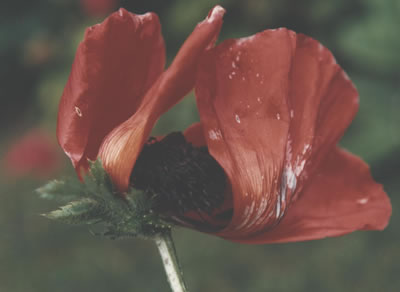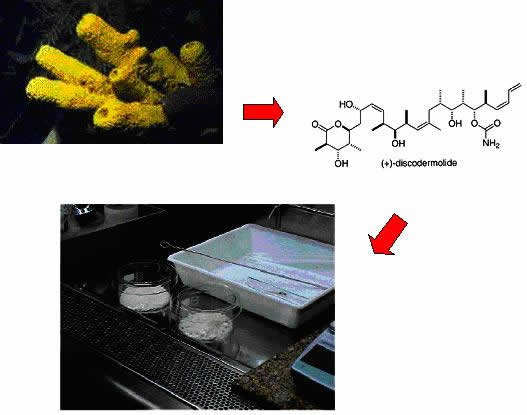Nature produces a seemingly limitless number of compounds that are valuable for treating disease. But when is a "natural product" unnatural? The answer is, when a chemist in a laboratory reproduces it artificially. A recent survey by the National Cancer Institute found that 61% of the 877 drugs introduced between 1981-2002 could be traced to, or were inspired by, natural products. Indeed, 78% of the anti-bacterials in current use, and 74% of anti-cancer drugs, owe their existence to nature.
But borrowing agents from nature to treat diseases is not a new idea. In the 1st century AD, the Roman writer Dioscorides documented the use of over 600 plants, many of which are still familiar today, in the ancient pharmaceutical text De Materia medica (Medical Matters). This work was subsequently relied upon by physicians in the Dark Ages, and continued to be accepted as an infallible authority until well into the 18th century. The concept was also further developed by the German shoemaker Jacob Boehmn (1575-1624) in his Signature rerum (The Signature of all Things), in which he argued that many herbs displayed give-away signs of the diseases that they could be used to treat. The lung wort, for example, was thought to be able to help patients with bronchial complaints, iris petals (because of their colouration) could ease bruising, Goldrenrod could bring relief from jaundice, and red plants could be used to treat anything that went wrong with the blood. Boehmn was almost certainly inspired by an ancient text called the Doctrine of Signatures, and similar ideas were also outlined by earlier medical writers including Galen, and the Swiss physician Paracelsus, who is noteworthy also for his discovery of the pain-killing potential of opium which comes from poppies. Indeed, so impressed was Paracelsus with the effects of opium that he named it "laudanum" from the latin "laudare" meaning to praise. Opium comprises a mixture of opiates, chiefly morphine, together with other active compounds such as papaverine, which is a muscle relaxant.
 |
| Figure 1: The red poppy, which produces morphine |
In terms of other effective remedies that owe their origins to nature, in the 17th Century powdered cinchona bark reached Europe from South America. The chemical that it contains, an alkaloid called quinine, is now used throughout the world to treat malaria. Its
effectiveness was confirmed by Robert Talbor, an apothecary's assistant, who used it to save the lives of Charles II of England, and Louis XIV of France.
Later, in 1775, William Withering, an English physician and botanist, also applied the principles of folk medicine and used the foxglove plant (Digitalis purpurea) for the treatment of 'dropsy' - a condition in which fluid accumulates in the skin or a body cavity, usually as a result of heart failure.
Hot on his heals, in 1803, came German scientist Friedrich Serturner, who was the first to isolate from poppy flowers (figure 1) one of our most powerful painkillers, morphine, which remains in widespread use today. Serturner originally named his new alkaloid morphia, after Morpheus the Greek god of dreams, but it is now termed morphine because, by convention, the names of all alkaloids end in -ine. His published paper also reports that he and three companions almost poisoned themselves with the new-found painkiller, all in the name of experimentation!
The identification of perhaps one of the most important alkaloids of all time, caffeine, came in 1819 when a young physician and chemist, called Friedlieb Ferdinand Runge, analysed a small collection of rare Arabian mocha beans given to him by the German poet-turned-scientist Baron Johann Wolfgang von Goethe.
Whilst all this was going on, native Indians in South America had, for centuries, been purifying their own powerful plant alkaloids in the form of the paralysing agent called ampi which is more commonly known as curare, meaning 'poison'. Curare is produced by the large Curare liana (vine) which grows in the canopy of the South American rainforest. By crushing and gently cooking the roots and stems, a light 'syrup' is produced which can be applied to the tips of arrows and darts for hunting game. The active ingredient, D-tubocurarine, and agents like it, are still used in hospitals today as neuromuscular blocking agents. Tubocurarine kills by paralysing the respiratory muscles, causing the victim to asphyxiate. Brazilians also use the extracts from the Curare vine as a diuretic, and for 'madness', oedema (swelling caused by fluid accumulating in the tissues), bruises, fever, and kidney stones.
As technology has moved forward, so the pace of natural products finding their way into the formulary has quickened. In recent years we have seen galantamine, which is extracted from daffodils, used to boost memory in patients with Alzheimer's disease, taxol, from yew trees, is a promising anti-cancer agent, and colchicine, which comes from the autumn crocus, is very good for relieving attacks of gout. Merck recently also launched a new anti-fungal agent derived from the fungus Glarea lozoyensis, in 2004 Novartis introduced a new anti-malarial agent based on Artemisia (sweet wormwood) extract, and a Spanish pharmaceutical company, called PharmaMar, which specialises in anticancer drugs based on marine natural products, have isolated an agent called Yondelis from the sea squirt Ecteinascidia turbinate.
But how do we decide which organisms might contain tomorrow's wonder drugs, and why do animals and plants sometimes go to extraordinary lengths to make these powerful chemicals anyway ? The answer lies in the arms race that has been going on throughout evolution between organisms of every species and their neighbours, with each attempting to protect itself by outwitting and out-manoeuvring the other with an array of deadly physical and chemical weapons. For example, stinging nettles have histamine-laden hypodermics to deter animals from eating them, brambles have sharp spines, tea and coffee plants resort to chemical-warfare and make caffeine to kill off plant pests that try to turn them into a meal, and fungi make antibiotics, like penicillin, to protect themselves from bacterial-attack.
Thankfully, some of these weapons also turn out to be useful drugs, and the organisms that harbour them often advertise the fact by using bright colours to warn off predators. Poison arrow frogs, for instance, exude from their skin a potent cocktail of alkaloids called histrionicotoxins. This toxin was first reported in 1823 by the western traveller Captain Charles Stuart Cochrane during an expedition around the lowland tropical rain forests of Colombia.
He encountered tribes of native Indians who used it to coat the tips of their arrows and blow-darts in much the same way that the South American Indians use curare. Cochrane's record of the practice is as follows:
"...called rana de veneno by the Spanish, about three inches long, yellow on the back, with very large black eyes....those who use poison catch the frogs in the woods and confine them in a hollow cane where they regularly feed them until they want the poison. The frog perspires very much, especially on the back, which becomes covered in a white froth; this is the most powerful poison that he yields, and in this they dip or roll the tips of their arrows, which will preserve their destructive power for a year. Afterwards, below this white substance, appears a yellow oil, which is carefully scraped off, and retains its deadly influence for four to six months, according to the goodness (as they say) of the frog. By this means, from one frog, sufficient poison is obtained for about fifty arrows."
So why spend years in a laboratory trying to make a compound if nature can do it for you ? The answer is that the natural source may only contain tiny amounts of the desired product, so large-scale harvesting would be both impractical and ecologically unacceptable.
For example, discodermolide, which was isolated in 1990 from the yellow Caribbean deep-sea sponge Discodermia dissolute (Figure 2), is currently being investigated by Novartis as a promising agent for the treatment of breast, ovarian and colon cancers. But collection of the sponge requires manned submersibles, and 50 tonnes of the frozen sponge yields just 1 gram of the drug so, in this instance, relying on nature to provide adequate amounts is clearly not feasible.
The alternative is therefore to borrow the idea from nature, and to make the substance artificially in the laboratory. Thankfully, chemists can now, using a 36-step reaction, produce over 60g of synthetic discodermolide from simple commercially-available starting materials.
 |
| Figure 2: The story of discodermolide. Identified originally in small amounts in the yellow Caribbean deep-sea sponge Discodermia dissolute, the chemical structure was identified, and is now produced synthetically in large amounts. |
So, by understanding the chemistry of nature, we can apply this knowledge to better understand forest management, agricultural needs, and make humans healthier. In the words of a pharmaceutical and biotechnology consultant, "when you have no idea where to begin in a drug discovery programme, nature is a good starting point".
ACKNOWLEDGEMENTS
Thanks to David Stevenson for use of the poppy photograph, and Gan Hup Tan for the use of the image of the discodermolide sea sponge.










Comments
Add a comment